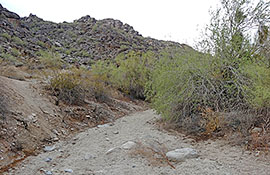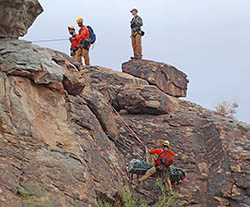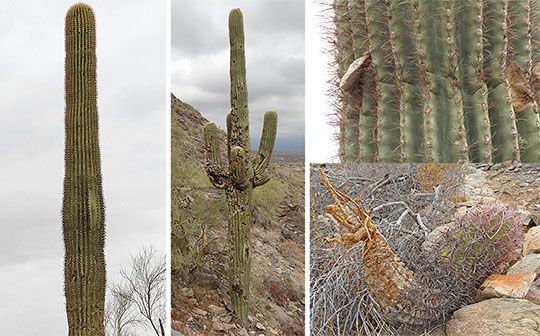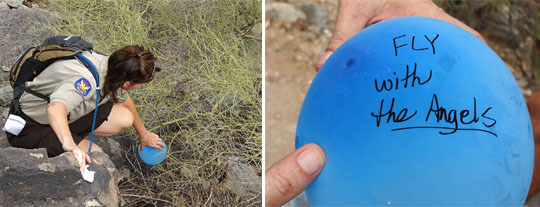
The early morning clouds are an unexpected sight. The desert this time of year is usually greeted by clear blue skies with the occasional puffy cumulus clouds in the distance. Today it is grey as far as you can see.
This is a good sign since it might make todays hike more comfortable. Summer in the desert can be as hot as 100 degrees Fahrenheit (38 °C) before noon. If the clouds last it might stay in the 90’s and if we are lucky the cool 80’s.

I’m in South Mountain Park about to start my hike up Holbert trail. As I look to the north is downtown Phoenix with its own kind of mountain skyline filled with skyscrapers. Ahead to the south is a two and half mile trail to the top.
This is also a special day because two park rangers will be my guides for today's trip. Earlier I met Justin Olson at the entrance to the park and he led me to the trailhead where Liz Smith has joined us. The three of us will be exploring the park. I have packed my usual gear plus I have my recording equipment because we will be making a podcast for our companion iTunes U show.
Where to Begin Your Hike
For today's hike I began by making plans. This is a good idea for any trip you might take, even short ones. I let several people know where I was going and when I should be back. This is a precaution in case I do not return as expected. I also made sure I brought along plenty of water and some trail bars in case I get hungry. I included a small first aid kit and a poncho in case it rains. Even in the desert it can rain and it is monsoon season so the chances are even better that I could get wet.
Even though it is cloudy I have on my usual broad-brimmed hat. The sun could come out anytime and I want to protect against too much sun exposure. For the parts of my skin that are not covered, I have already put on a generous amount of sunscreen.

First Steps
Standing at the trailhead I ask about the first thing a person should do when they begin a hike. Liz takes me to the Park Map and says this is the perfect place to start. If you have a map of where you are going, it is a good idea to take it with you. In this case the trail is not long or complicated so a review of the map at the trailhead is going to do the trick for this trip.
As we begin walking I take a look up towards the top of the mountain. It looks pretty brown and even bare, but the desert and this park have many hidden secrets. You just need to know where to look.
We Are Not the First Travelers

The Holbert trail is a popular spot for people in the Phoenix area. There are thousands of hikers each year, but we are not the first to walk this mountain. There have been people living in this area for thousands of years. The Hohokam are native people who called South Mountain home.
Justin stops us just as we make our way around the first bend. He points to the ground to an area that I would certainly missed if he had not pointed it out. On the ground is piece of broken pottery. It is brown and almost blends in with sandy ground. A rain shower the night before had washed some of the ground away revealing the treasure.
After a few more curves and twists in the trail Liz points to a rock. On the rock are some images. These are also something I might have missed in my hurry to get to the top of the mountain because they also blend into their surroundings. Created by the same people who made the pottery these petroglyphs are chipped, or pecked into rocks. It turns out that I am not just taking a hike I am traveling back in time.
We leave the petroglyphs and soon find ourselves walking through a dry wash that are also called arroyos. Dry rivers and streams are common in the desert. Most of the time they do not have any water in them, but they can fill quickly with the smallest of rainstorms. We stop and Liz and Justin point out several of the plants that take advantage of the limited water that funnels through these washes. There are Ironwood and Palo Verde trees, and Creosote bushes. Located in the Ironwood tree is what looks like a bird nest but is instead mistletoe.


Life needs water and desert washes, called arroyos, provide this key ingredient in the dry land. Plants and animals commonly line these water sources.
Click on the images to enlarge or click on the player below to listen to rangers Liz Smith and Justin Olson talk about the desert arroys in South Mountain Park. You can also play the mp3 file here.
Once we leave the wash we begin our climb up the mountain. There are the usual hikers and mountain bikers who pass us as we talk about the park. To the left is a group of people in an area off trail. It looks like a rescue is underway. A stretcher is carefully being lowered from a rocky peak.
I ask my guides what is going on and Justin says it is actually a good thing. This is Central Arizona Mountain Rescue Association (CAMRA) and the new recruits are taking their exam to become a member of the team. If they pass they can be called if anyone might run into trouble in the parks and need to be rescued. This is an all-volunteer group that does not get paid. They even buy their own gear.

The trail has become steeper and I am working harder as we walk. My breathing is also much more rapid. At times I feel like I just finished my morning run. The only difference is it is still a long way to the top.
At our next break Liz points down to the trail we just came up from and also all the spider trails that people have created. These trails have an unfortunate effect on the land. Where there would be native plants there is just bare sand, rocks and gravel. It is a reminder to stay on trail.
Saguaro Cactus Story Tellers
I look up at the sky. The clouds are sticking around making our trip more comfortable. In the distance I see some rain falling. We talk more about rainstorms and how they can change the mountain. Liz points out a young Saguaro cactus that is on its side. The night before a storm had been so strong that it washed the sallow roots out from under the cactus. Plant roots in the desert commonly stay close to the surface so they can take in as much water as possible in this dry climate.
Further up the trail an older cactus tells a different story about water. The saguaro cactus can store water in its trunk for up to seven years. Liz tells me that if you look at the trunk of the cactus you can tell when there were seasons had more or less rain. This cactus has a bulge that might have occurred 20 years ago. Since then the trunk has been narrowing. This is a sign that there have been many years with less rain.

Saguaro cacti are great storytellers. Click on the image to read about these desert giants, or click on the player below to listen to rangers Liz Smith and Justin Olson talk about the desert arroys in South Mountain Park. You can also play the mp3 file here.
Another quarter of a mile walking and we take a water break. The rule for hiking in the desert is to take a drink about every eight minutes. This will keep your body hydrated in the hot dry desert. As we drink, I look out at the mountainsides. Some have a lot of saguaro cacti and others have none. Liz explains that saguaro's prefer the north facing side of the mountains. It helps to protect them from the strong, hot sunlight. The next time you are out for a drive or hike in the desert you can see the same thing.
The Desert Has Plenty of Color

When we started our hike I was reminded of a cousin of mine who is quite the outdoors person. She loves to backpack and camp, but never in the desert. She says it is boring. There is nothing to see and everything is brown. I mentioned to her that there is a lot to see in the desert. You just need to know where to look.
In South Mountain Park you can find a range of color on most of the rocks. Lichens cover the rocks in range of greens reds. These are not plants but a combination of fungus and algae that can live in the harshest of climates.
Leave No Trace and Our Role
As we get close to the top of Holbert trail we stop to look at an old saguaro cactus. We know it is old because it has many arms. The saguaro will not grow its first arm until it is 50 to 70 years old. This giant has five arms. Justin explains that unfortunately this cactus may not have many more years to live. It is close to the trail and has become a target for thoughtless hikers who enjoy seeing if they can throw a rock hard enough to dig into the protective skin of the plant. It's a silly game that will end the life of this old giant.

At the base of the saguaro is a bright blue balloon. Liz carefully hikes down to the base to pick up the baloon. She returns and shows me that it is inscribed with a wish for a recently departed family member or friend. They hike or drive to the top of the mountain to release balloons as a memorial. It is a kind gesture, but the outcome can be dangerous for wildlife. Once the balloon loses its helium and lands in the park animals are attracted to it. If they eat it there is a good chance they will throw up the material along with any water they might have. The added stress can be life threatening for the animal.
Rewards of the Hike
With the top of the mountain in sight I take a look back at the valley. The clouds have been great companions for the day. Even with them we have all broken into a sweat. It is good that we brought plenty of water. The clouds also look like they are bringing some welcome rain. I think of the arroyo we had to cross at the beginning of the hike. I wonder if we will have a flash flood in that wash. The mountainous skyline of downtown Phoenix looks like it is already getting rain. Perhaps we will not linger at the top so we can get back before the rain comes? It is a good thing that I brought my poncho. It might be a wet walk back.

Read more about: Walk in the Park
Bibliographic details:
- Article: Walk in the Park
- Author(s): Dr. Biology, Justin Olson, Elizabeth Smith
- Publisher: Arizona State University School of Life Sciences Ask A Biologist
- Site name: ASU - Ask A Biologist
- Date published:
- Date accessed:
- Link: https://askabiologist.asu.edu/explore/walk-park
APA Style
Dr. Biology, Justin Olson, Elizabeth Smith. (). Walk in the Park. ASU - Ask A Biologist. Retrieved from https://askabiologist.asu.edu/explore/walk-park
Chicago Manual of Style
Dr. Biology, Justin Olson, Elizabeth Smith. "Walk in the Park". ASU - Ask A Biologist. . https://askabiologist.asu.edu/explore/walk-park
Dr. Biology, Justin Olson, Elizabeth Smith. "Walk in the Park". ASU - Ask A Biologist. . ASU - Ask A Biologist, Web. https://askabiologist.asu.edu/explore/walk-park
MLA 2017 Style

South Mountain Park allows you to travel back in time with the many petroglyphs that can be viewed from the trails that are a thousand or more years old.
Be Part of
Ask A Biologist
By volunteering, or simply sending us feedback on the site. Scientists, teachers, writers, illustrators, and translators are all important to the program. If you are interested in helping with the website we have a Volunteers page to get the process started.

